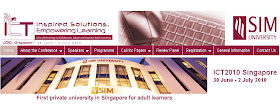 Introduction
IntroductionICT2010 Singapore is an educational technology conference for academics, researchers, instructors and practitioners for the purpose of exchanging information and facilitating discussions on adult learning. The conference to be held from 30 June to 2 July is hosted by SIM University as part of its fifth anniversary celebration. The conference theme - "Inspired Solutions, Empowering Learning: Using Technology to Collaborate, Adapt and Improve Adult Learning" - focuses on how to use technology to help adult learners or mature students learn more effectively and efficiently at their own pace, space and time.
This two-and-a-half day conference features four keynote speakers. They are prominent academics well versed in their fields of expertise related to educational technology, online learning strategies and the design and development of e-content. In keeping with the subject of information communication technology, the conference will have two of its keynotes deliver presentations online.
Day 1 is set aside for peer-reviewed presentations of full papers, whilst Day 2 will showcase brief papers and poster presentations. Day 3 will be a half-day of post-conference workshops and/or visits to educational institutions, such as "Future Schools", which have, or are supporting a high level of e-Learning activities. All presentations will be in English.
ICT2010 has the support of Infocomm Development Authority of Singapore (IDA), and the Open University of Hong Kong (OUHK). In fact, the conference has its roots in a series of international conferences on "ICT in Teaching and Learning", jointly organised by OUHK and the Hong Kong Web Symposium Consortium since 2006.
Presentation ContentsWe invite submissions of full and brief papers and poster presentations on three key areas linked to the conference theme, "Inspired Solutions, Empowering Learning - using technology to collaborate, adapt and improve adult learning." The focus is on how to help adult learners or mature students learn more effectively and efficiently, at their own pace, space and time.
The three key areas are:
1. Engaging Learners
Using technology to engage learners involves adapting instructional strategies that activate prior knowledge, facilitate cognitive development and promote long-term retention and transfer of skills to the workplace. What have we learned from using technology to engage learners?. Does technology adapt to specific instructional technologies or vice-versa? Is there an "e-Pedagogy" that suits the "Net Generation" of learners?
Show topics
* Audio/video Casting
* Blogging/Micro-blogging
* Classroom Techniques
* Facilitating Learning
* Interactive Content
* Social Learning/Community of Learning
2. Empowering Teaching and Learning
The roles and expectations for teaching and learning are changing, especially in an environment where technology prevails. Does technology add to a larger divide between teaching and learning, or is it a bridge to bring teaching and learning, knowledge and experience closer together? In what ways does technology empower teachers to expand their teaching strategies/practices and learners to express themselves?
Show topics
* Blended Learning
* Collaborative Learning / wiki
* e-Mentorings
* Electronic Portfolios
* Educational Psychology
* ICT Educator's Development
* Life Long Learning
* Rapid e-learning
* Strategic Leadership
* Virtual Communities
3. Emerging Technologies
The proliferation of technology in education and training is relentless. With the increased adoption of technology, learning anywhere, anyplace and anytime is increasingly a reality which is especially welcomed by part-time adult learners who are busy professionals. But how do we choose the right technology which can give the best impact on learning? How do we avoid putting technology first before pedagogy in our need or desire to free-up teaching and learning from the constraints of the classroom? Are we creating opportunities to support technological innovations that enhance curricula development or just creating more bells and whistles?
Submission DetailsKey dates at a glance
Abstract (Full/Brief Paper/Best Practice Presentation) submission deadline:
30 November 2009
Abstract acceptance notification:
31 December, 2009
Full/brief paper submission deadline: 28 February 2010
Review panel submission period: 1 March to 1 May 2010
Presentation-ready paper submission deadline: 31 May 2010
We invite submissions of Full and Brief papers, and Best Practice Presentations.
Full Paper: 1. Create a user account.
2. Submit an abstract of up to 1,000 words for review and acceptance.
3. Submit a full research report of between 8 to 10 pages and up to 5,000 words for review (12-point Times New Roman font is recommended)
4. Revise full research paper based upon reviewers' recommendations.
5. Submit final paper and register for conference.
6. Present paper at conference (25 minutes including Q & A session).
Brief Paper: 1. Create a user account.
2. Submit an abstract of up to 500 words for review and acceptance.
3. Submit a brief reflection report of between 4 to 6 pages and up to 2,500 words (12-point Times New Roman font is recommended).
4. Revise brief reflection report based upon reviewers' recommendations.
5. Submit final paper and register for conference.
6. Present paper at conference (15 minutes including Q & A session).
Best Practice Presentation: 1. Create a user account.
2. Submit a write-up of at least 1,000 words of a Best Practice Presentation for review and acceptance (12-point Times New Roman font is recommended).
3. Present paper at conference (15 minutes including Q & A session).
Format for Abstract, Full/Brief Paper and Best Practice Presentation:
* Refer to Author's Guidelines
* Refer to Review Criteria
Note:
Presenters must submit the final version of Full/Brief Papers and/or Best Practice Presentations and register for the conference by 31 May 2010 to have their work included in the Conference Proceedings CD-ROM.
Eligibility for Best PaperAll papers published in the conference proceedings shall be eligible for the Best Paper Award in each key area. The chosen paper must be original and has not been published elsewhere. Only authors who attend and present their respective papers at the conference are eligible to be considered for the award.
Authors of best papers will be recommended to submit their papers to the following journals:
* International Journal of Innovation and Learning
* Asean Journal of Open and Distance Learning
* Interactive Technology and Smart Education
Details at:
http://www.unisim.edu.sg/uni/pub/ICT2010/index.html







